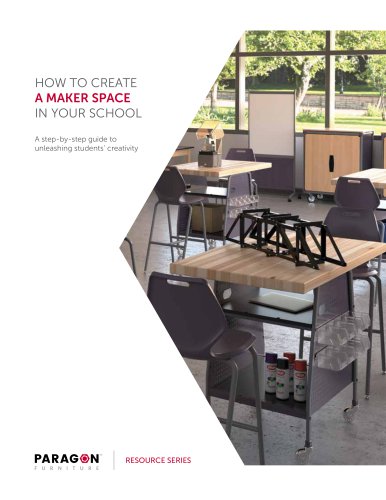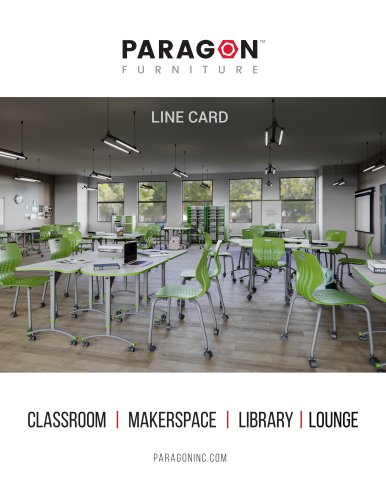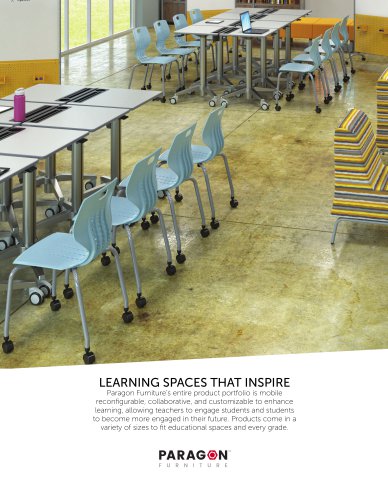 Website:
PARAGON FURNITURE INC
Website:
PARAGON FURNITURE INC
Catalog excerpts

HOW TO CREATE A MAKER SPACE IN YOUR SCHOOL A step-by-step guide to unleashing students’ creativity RESOURCE SERIES
Open the catalog to page 1
Crafting your vision Chapter 2 Designing your maker space Chapter 3 Transforming the role of the teacher
Open the catalog to page 3
The “maker movement” is catching on in education, and it’s easy to see why. Looking to inspire the next generation of tinkerers and innovators, a growing number of schools are creating spaces to unleash students’ creativity. These spaces, which are equipped with everything from popsicle sticks and glue guns to electronics kits and 3D printers, can go by many different names. In some schools, they’re called “dream labs.” In others, they might be referred to as “innovation spaces.” To keep it simple, we will refer to them as “maker spaces” throughout this guide. When educators encourage...
Open the catalog to page 4
The maker movement isn’t really a new concept. “Montessori said that when you work with your head, your heart and your hands, it all works together,” says Sylvia Martinez, co-author of the book Invent to Learn: Making, Tinkering and Engineering in the Classroom. Learning by creating “is good pedagogy,” she says, explaining that the idea can be traced from Rousseau to John Dewey, Piaget and others throughout history. But one thing that’s different today is the sophistication of the tools that are available to students. As recently as 10 years ago, K-12 students would not have been able to...
Open the catalog to page 5
CRAFTING YOUR VISION
Open the catalog to page 6
As is true when developing any plan, it’s important to start with your vision for the space and outline the goals you hope to accomplish. Your vision and goals will help you answer other critical questions, such as what the space should look like, how it will be equipped and so on. Here are four key questions to guide your initial planning efforts.
Open the catalog to page 7
Eight Essential Elements of a Good Maker Space Project Are you looking for a template to follow when designing high-quality maker space experiences? In their book Invent to Learn, authors Sylvia Martinez and Gary Stager describe these eight characteristics of a good maker space project: • Purpose and relevance. Is the project personally meaningful to students, so they feel invested in it? • Time. Have you given students enough time to plan, carry out, test and revise their work?
Open the catalog to page 8
• Which grade levels or age ranges is your maker space intended for? Grades K-2, 3-5, 6-8, 9-12, adults or some combination • Which classes and academic disciplines will use the space? Is it meant only for certain subject areas or for all academic subjects? • Will you open your maker space to members of the public, such as adults for night classes or students from other schools? • Complexity. Does the problem require knowledge from multiple subject areas to solve? • Intensity. Does the project provide an outlet for students to deeply engage with the material? • Connection. Are students...
Open the catalog to page 9
2. How, and when, will students use the space? • Will the space be used for formal, structured learning activities led by a teacher? Informal, student-directed learning and • Will students use the space during school hours? Before or after school? Or both?
Open the catalog to page 11
3. What are your instructional goals? • What are you hoping students will learn by using the maker space—core academic skills, 21st century skills, or both? • If core academic learning is your target, how do your intended learning activities align with state instructional standards, Next Generation Science Standards, or other curriculum goals? • If 21st skills are your desired outcome, which specific skills are you hoping students will acquire? How will the activities completed in the space lead to the development of these skills? Chicago Offers a Successful Maker Space Model With support...
Open the catalog to page 12
and engaging by integrating digital media into the curriculum of Morrill Math and Science School, which serves grades K-8, and Tilden Career Community Academy, which serves grades 9-12. During the school day, teachers take their students into the digital atelier to complete hands-on projects using technologies such as graphic design software, video editing tools, electronics kits and 3D printers. During lunch and after school, the ateliers provide a safe and comfortable place for students to gather and explore 21st century skills under the guidance of artists and other professionals, called...
Open the catalog to page 13
Chicago Offers a Successful Maker Space Model (continued) “Students learn in multiple ways,” says Mindy Faber, co-director of the Convergence Academies project. Besides learning in the classroom, “they learn through their peer culture, and their interests motivate their learning.” But many schools have been slow to cultivate the learning that happens when the school day ends, Faber says—and the Convergence Academies model could be one way to change that. There is evidence to suggest the program is having a big impact on student success. Morrill has moved from a Level 3 to a Level 1 school...
Open the catalog to page 14
4. How will you measure success? • What methods will you use to evaluate the success of your maker space initiative? Formal measurements of the skills students gain, informal observation and reflection, or both? • If you’re measuring the skills that students gain, what types of assessments will you use? How will you put these together? • If you’re using informal observation and reflection, how will you collect his information? Teacher observation forms, post-program t surveys of students or some other method? Tilden’s average attendance increased since the program began in 2013. Tilden’s...
Open the catalog to page 15
Once you have a plan for how your maker space will be used, you can design the actual space itself. 2 Issues you’ll want to consider include location, configuration, tools and materials, storage and utility and safety. Here’s a closer look at each of these aspects.
Open the catalog to page 17All PARAGON FURNITURE INC catalogs and technical brochures
-
LINE CARD
11 Pages
-
LEARNING SPACES THAT INSPIRE
60 Pages
-
Paragon-Furniture-Color-Guide
32 Pages






